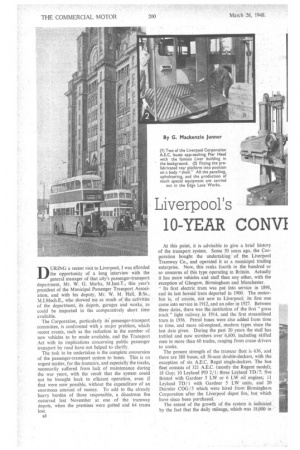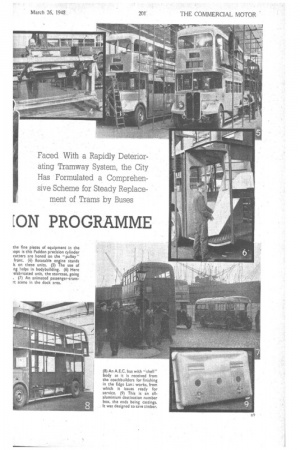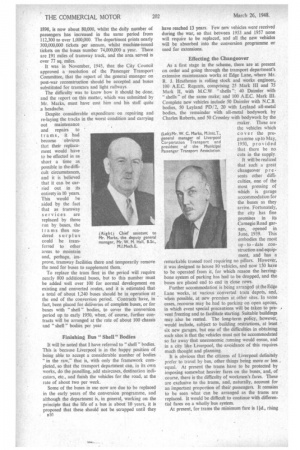10-YEAR CONVI ON PROGRAMME
Page 42

Page 43

Page 44

If you've noticed an error in this article please click here to report it so we can fix it.
DURING a recent visit to Liverpool, I was afforded the opportunity of a long interview with the general manager of that city's passenger-transport department, Mr. W. G. Marks, M.Inst.T.,, this year's president of the Municipal PasSenger Transport Association, and with his deputy, Mr. W. M. Hall, B.Sc., M.I.Mech.E., who showed me as much of the activities of the department, its depots, garages and works, as could be inspected in the comparatively short time
available. .
The Corporation, particularly its passenger-transport committee, is confronted with .a. major problem, which recent events, such as the reduction in the number of new vehicles to be made available, and the Transport Act with its implications concerning public passenger transport by road have not helped to clarify.
The task to be undertaken is the complete conversion of the passenger-transport system to buses. This is an urgent matter, for the tramcars, and especially the tracks, necessarily suffered from lack of maintenance during the war years, with the result that the system could not be brought back to efficient operation, even if that were now possible, without the expenditure of an enormous amount of money. To add to the already heavy burden of those responsible, a disastrous fire occurred last November at one of the tramway depots, when the premises were gutted and 64 trams lost.
a8 At this point, it is advisable to give a brief history of the transport system. Some 50 years ago, the Corporation bought the undertaking of the Liverpool Tramway Co., and operated it as a municipal trading enterprise. Now, this ranks fourth in the hundred or so concerns of this type operating in Britain. Actually it has more vehicles and staff than any other, with the exception of Glasgow, Birmingham and Manchester.
' Its first electric tram was put into service in 1898, and its last •horsed train departed in 1900. The motorbus is, of course, not new to Liverpool; its first one came into service in 1912, and an oiler in 1927. Between these dates, there was the institution of the first "grass • track" light railway ,in 1914, and the first streamlined tram in 1936. Petrol buses were also added from time to time, and more oil-engined, modern types since the last date given. During the past 20 years the staff has trebled and now numbers over 6,600, including skilled men in more than 60 trades, ranging from crane drivers to cooks.
The present strength of the tramcar fleet is 636, and there are 388 buses, all 56-seat double-deckers, with the exception of six A.E.C. Regal single-deckers. The bus fleet consists of 321 A.E.C. (mostly the Regent model); 18 Guy; 10 Leyland PD 2/1; three Leyland TD/ 7; five Bristol with Gardner 5 LW or 6 LW oil engines; 11 Leyland TD /1 with Gardner 5 LW units, and 20 Daimler COG / 5 which were hired from Birmingham Corporation after the Liverpool depot fire, but which have since been purchased.
The extent of the growth of the system is indicated• by the fact that the daily mileage, which was 18,000 in
1898, is now about 80,000, whilst the daily number of passengers has increased in the same period from 112,300 to over 1,000,000. The department prints nearly 300,000,000 tickets per annum, whilst machine-issued tickets on the buses number 74,000,000 a year. There are 191 miles of tramway track, and the area served is over 77 sq. miles.
It was in November, 1945, that the City Council approved a resolution of the Passenger Transport Committee, that the report of the general manager on post-war reconstruction should be accepted and buses substituted for tramcars and light railways
The difficulty was to know how it should be done, and the eport on this matter, which was submitted by Mr. Marks, must have cost him and his staff quite a headache.
Despite considerable expenditure on repairing and re-laying the tracks in the worst condition and carrying out maintenance and repairs to trams, it had become obvious that their replacement would have to he effected in as short a time as possible in the difficult circumstances, and it is believed that it can be carried out in its entirety in 10 years. This would he aided by the fact that as tramway
services are replaced by those run by buses, the trams thus rendered surplus could be transferred to other areas to maintain and, perhaps, improve, tramway facilities there and temporarily remove the need for buses to supplement them.
To replace the tram fleet in the period will require nearly 800 additional buses, but to this number must be added well over 100 for normal development on existing and converted routes, and it is estimated that• a total of about 1,240 buses should be in operation at the end of the conversion period. Contracts have, in fact, been placed for deliveries of complete buses, or for buses with "shell " bodies, to cover the conversion period up to early 1950, when, of course, further contracts will be arranged at the rate of about 100 chassis and " shell " bodies per year Right) Chief assistant to Mr. Marks, the deputy general manager, Mr. W. M. Hall, B.Sc., M.I.Mech.E.
Finishing Bus " Shell" Bodies
It will be noted that I have referred to " shell " bodies. This is because Liverpool is in the happy position of being able to accept a considerable number of bodies "in the raw," that is, with only the framework completed, so that the transport department can, in its own works, do the panelling, add staircases, destination indicators, etc., and finish the vehicles for the road, at the rate of about two per week.
Some of the buses in use now are due to be replaced in the early years of the conversion programme, and although the department is, in general, working on the principle that the life of a bus is about 10 years, it is proposed that these should not be scrapped until they have reached 13 years. Few new vehicles were received during the war, so that between 1953 and 1957 none will require to be replaced, and all the new vehicles will be absorbed into the conversion programme or used for extensions.
Effecting the Changeover As a first stage in the scheme, there are at present on order and going through ihe transport department's extensive maintenance works at Edge Lane, where Mr. R. J. Heathman is rolling stock and works engineer, 100 A.E.C. Regents, comprising 25 Mark III and 75 Mark II, with M.C.W " shells ": 40 Daimler with " shells " of the same make; and 100 A.E.C. Mark III. Complete new vehicles include 50 Daimler with N.C.B. bodies, 50 Leyland PD / 2, 20 with Leyland all-metal bodies, the remainder with all-metal bodywork by Charles Roberts, and 50 Crossley with bodywork by the maker. These are the vehicles which cover the programme up to May, 1950, provided that there be no cuts in the supply.
(Left) Mr. W. C. Marks, M.Inst.T., general manager of Liverpool Corporation Transport and president of the Municipal Passenger Transport Association
It will be realized that such a great changeover p r e sents other difficulties, one of the most pressing of which is garage accommodation for the buses as they arrive. Fortunately, the city has fine premises in its Carnegie Road garage, opened in June, 1939. This embodies the most up to date construction and equipment, and has a remarkable trussed roof requiring no pillars. However, it was designed to house 80 vehicles, and now 150 have to be operated from it, for which reason the herringbone system of parking has had to be dropped, and the buses are placed end to end in close rows.
Further accommodation is being arranged at the Edge Lane works, at various converted tram depots, and, when possible, at new premises at other sites. In some cases, recourse may be had to parking on open aprons, in which event special precautions will be taken to pre. vent freezing and to facilitate starting. Suitable buildings may also be rented. The long-term policy, however, would include, subject to building restrictions, at least six new garages, but one of the difficulties in obtaining such sites is that the vehicles must not be accommodated so far away that uneconomic running would ensue, and in a city like Liverpool, the -avoidance of this requires much thought and planning.
It is obvious that the citizens of Liverpool definitely prefer to travel by bus, other things being more or less equal. At present the trams have to be protected by imposing somewhat heavier fares on the buses, and, of course, there is the difficulty of workmen's fares. These • are exclusive to the trams, and, naturally, account for an important proportion of their passengers. It remains to be seen what can be arranged as the trams are replaced. It would be difficult to continue with differential fares on a wholly bus system.
At present, for trams the minimum fare is lid., rising




















































































